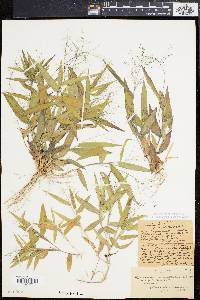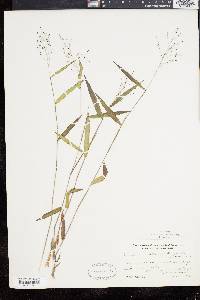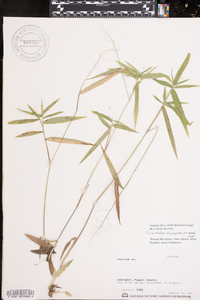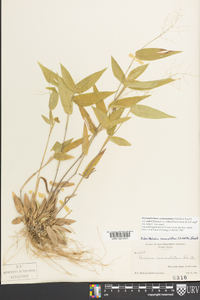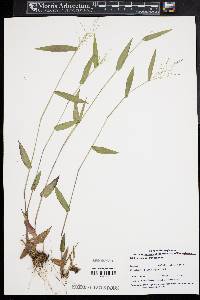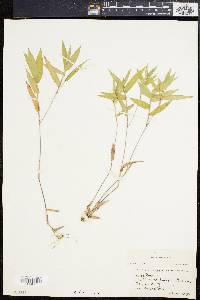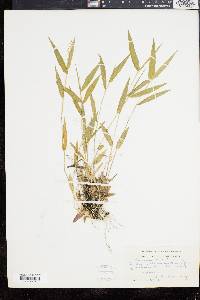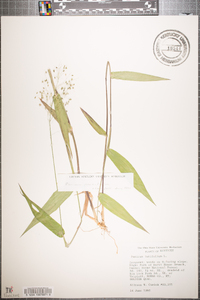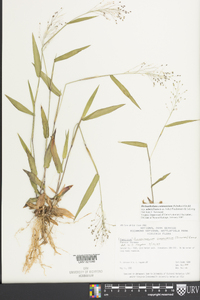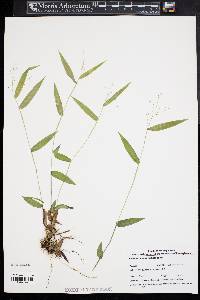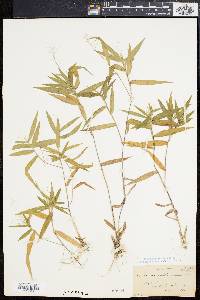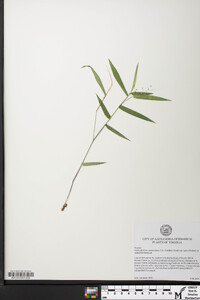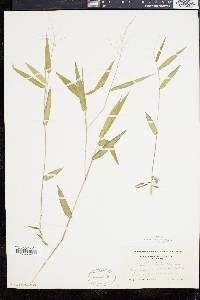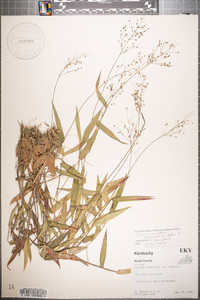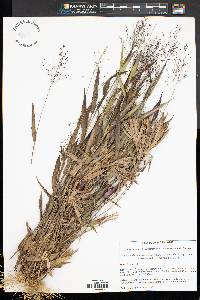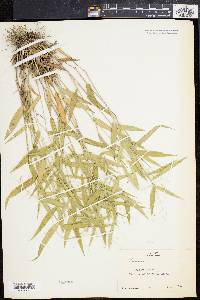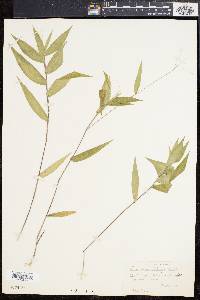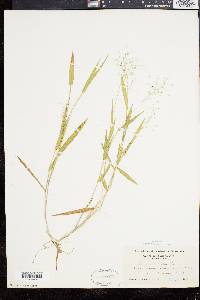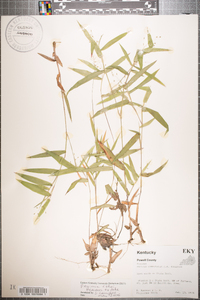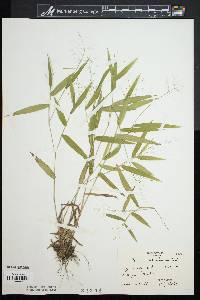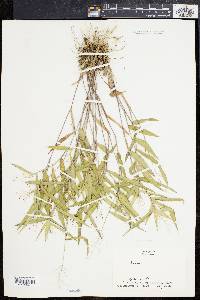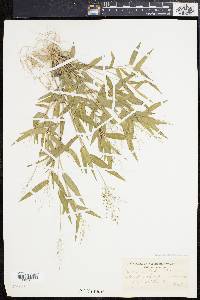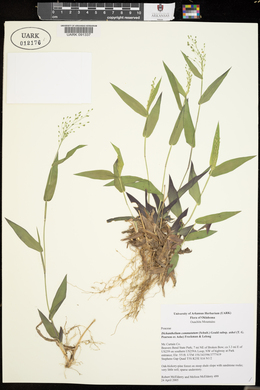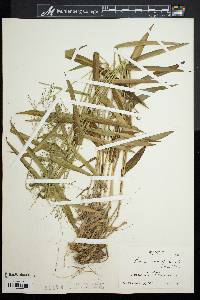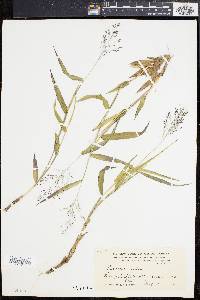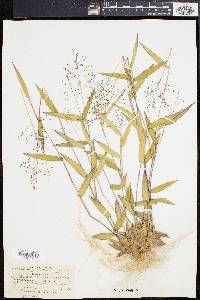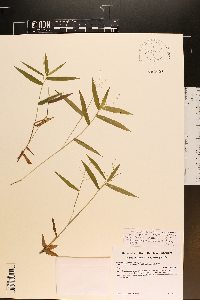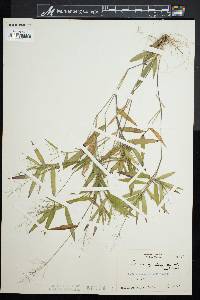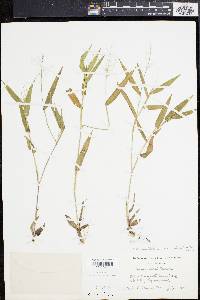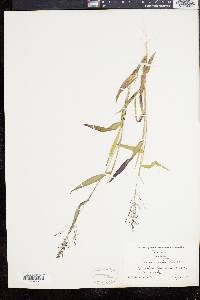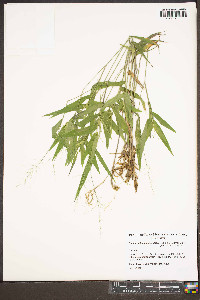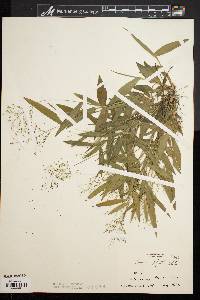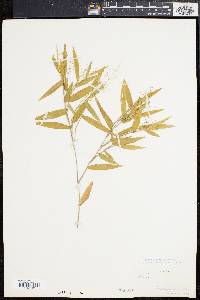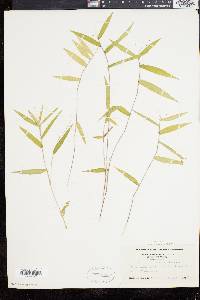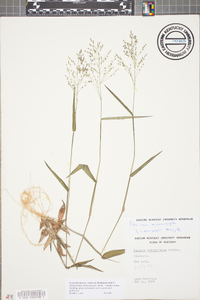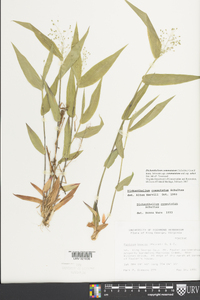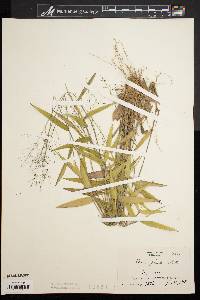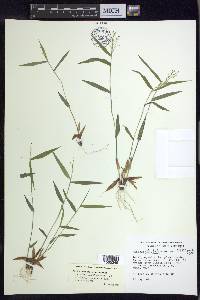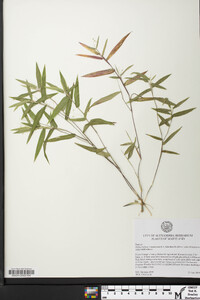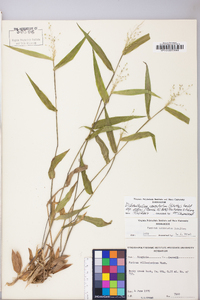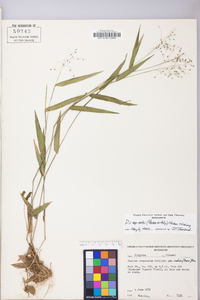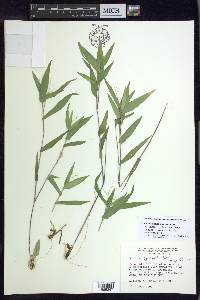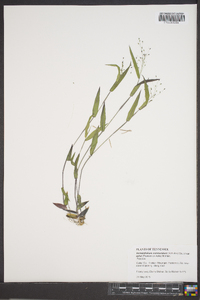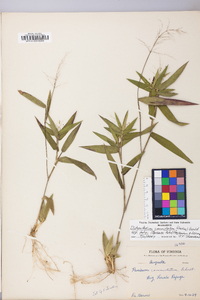Dichanthelium commutatum subsp. ashei
|
|
|
|
Family: Poaceae
Ashe's Witch Grass
[Dichanthelium ashei (T.G. Pearson ex Ashe) Mohlenbrock, moreDichanthelium commutatum var. ashei (Pearson ex Ashe) Mohlenbr.] |
Plants from small caudices. Culms slender, wiry, erect, densely crisp-puberulent. Basal blades usually shorter than 3 cm, to 6 mm wide. Cauline blades 5-8 cm long, 5-10 mm wide, linear-lanceolate, thick, often yellowish-green, bases symmetrical. Spikelets 2.2-2.7 mm. Lower glumes 1/5-1/4 the length of the spikelets; lower lemmas pointed. Dichanthelium commutatum subsp. ashei grows in open woodlands. It sometimes resembles, and may hybridize with, D. dichotomum. Perennial herb, tufted 20 cm - 0.75 m tall Inflorescence: a terminal, branched arrangement of spikelets (panicle). Panicles atop the culms, open, 5 - 12 cm long, 3 - 10 cm wide, exserted. Secondary panicles (when present) atop the branches. Fruit: a caryopsis, indehiscent, enclosed within the persistent lemma and palea. Culm: upright, often purplish, 20 cm - 0.75 m long, wiry, round in cross-section, hollow, densely crisp-hairy. Fall phase nearly upright, eventually sprawling, sparsely rebranching, producing leaf blades and secondary panicles that are smaller than those of the culms. Spikelets: purplish or yellowish green, 2 - 2.5 mm long, over 1 mm wide, narrowly ellipsoid, and hairy. Basal leaves: in a rosette. Blades usually less than 3 cm long, to 6 mm wide, egg-shaped to lance-shaped, distinct from stem blades. Stem leaves: four to six, alternate, two-ranked. Sheaths purplish or olive-colored, usually shorter than internodes, often having a waxy coating (glaucous), sometimes minutely hairy, often fringed with hairs. Ligules less than 0.5 mm long, shortly membranous, fringed with hairs (hairs longer than membranous area). Blades thick, often yellowish green, distinctly longer and narrower than basal leaves, 5 - 8 cm long, 0.5 - 1 cm wide, linear to lance-shaped with a clasping, heart-shaped base, symmetrical basally, many-veined, sometimes minutely hairy, fringed with bumpy-based hairs. Glumes:: Lower glumes one-fifth to one-fourth as long as the spikelets. Upper glumes equal to or slightly shorter than spikelets, rounded to pointed at the apex. Lemmas:: Lower lemmas similar to upper glumes, equal to or slightly shorter than spikelets, pointed. Upper lemmas longitudinally lined, shiny, with rolled-up margins above. Paleas:: Lower paleas shorter than lower lemmas, thin. Upper paleas longitudinally lined. Florets:: Lower florets sterile. Upper florets bisexual, stalkless, plump, often bearing a tiny protuberance at the apex. Anthers three. Stigmas red. Similar species: No information at this time. Flowering: late May to late August Habitat and ecology: Confined to the eastern sector of the Chicago Region, and found only in the dune region of Lake Michigan. Dry woods. Occurence in the Chicago region: native Etymology: Dichanthelium comes from the Greek words di, meaning twice, and anth, meaning flowering, referring to plants that may have two flowering periods. Commutatum means changing. Ashei is named after William Willard Ashe (1872-1932), the American botanist who discovered this subspecies. Author: The Morton Arboretum From Flora of Indiana (1940) by Charles C. Deam This species [Deam's Panicum ashei], as now known in the state, is restricted to the unglaciated area, with the exception of a typical specimen which I have from Porter County found on a sandy black oak and white pine ridge about 4 miles southwest of Michigan City. In the southern part of the state it is found mostly on the crests and slopes of chestnut oak ridges. No single character will separate Indiana specimens of this grass from those of the next [Panicum commutatum]. The two plants intergrade to such an extent that it is questionable whether an attempt should be made to keep them separate, even regarding one as a variety, as has been done by Fernald (Rhodora 36: 83-87. 1934). If all of our forms of this species complex are considered as one species, then the same treatment applied to borderline species in other groups would unite them. This case seems to be a decision between the "grouping" and the "splitting" of forms (species). Until an exhaustive study is made of the group, any disposition made of these plants must be mere opinion or for convenience. For these reasons I am following Hitchcock and treating our plants as two species. Such treatment leaves the problem open to future study. ...... Indiana Coefficient of Conservatism: C = 7 Wetland Indicator Status: FAC |

